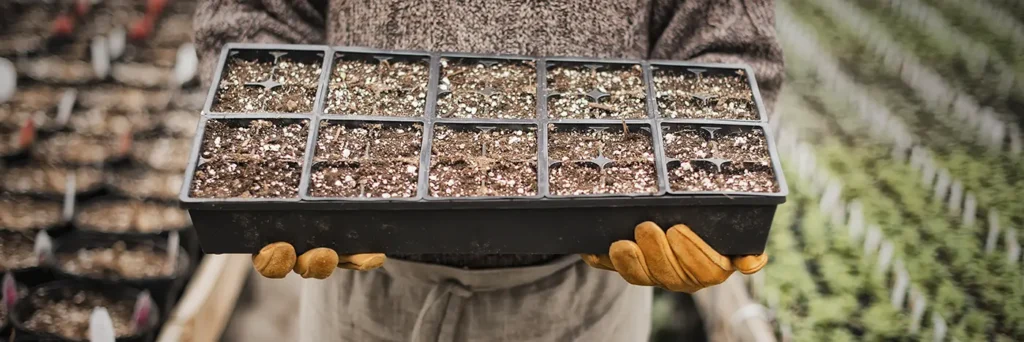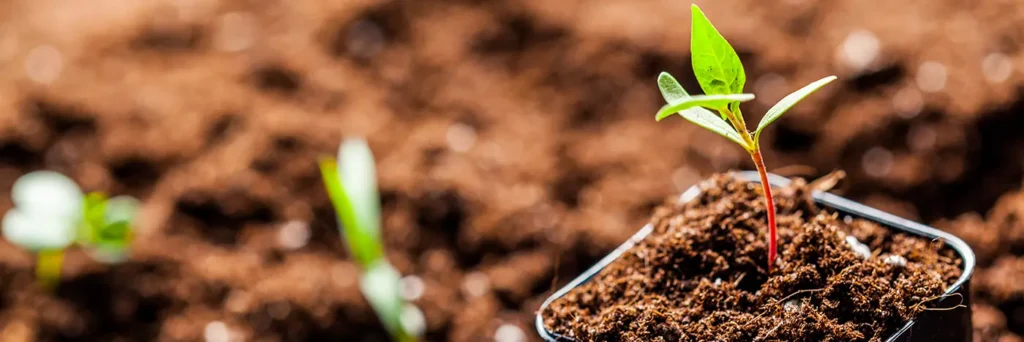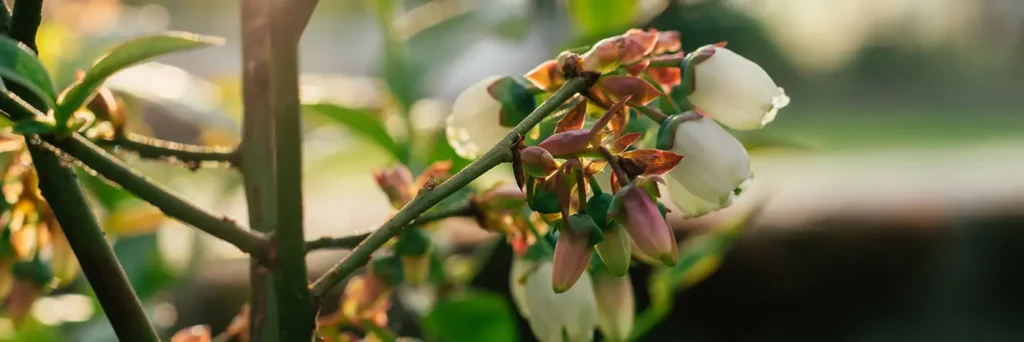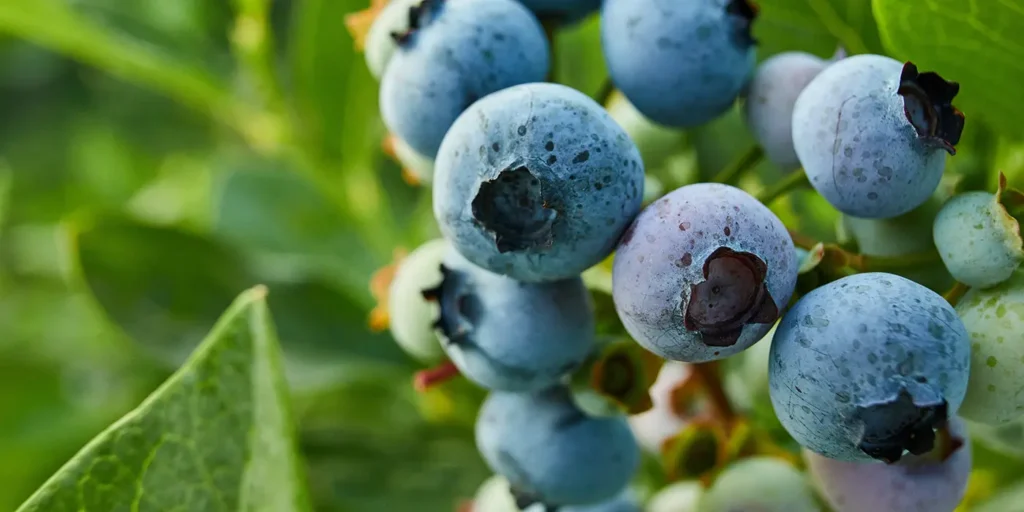Blueberry is a shrub berry, and its nutritional value is far higher than that of apples, grapes and other fruits. It is called the king of fruits and has great development and cultivation value.
In order to promote the increase of blueberry production and income, we can artificially control and adjust many factors of blueberry planting through greenhouse cultivation, so as to achieve the goals of off-season production and high yield, high efficiency and high quality, and extend the supply period of fresh blueberry fruits, avoid frost during flowering period, rain during fruit picking period and many other unfavorable factors, so as to significantly improve the yield and benefit of blueberries.
The following is a detailed cultivation and management technology for blueberry greenhouse production for reference by farmers.
Ⅰ. Construction of solar greenhouse
- Site selection of greenhouse
Solar greenhouses should be built in places with flat terrain, good light, high soil organic matter content, convenient drainage and irrigation, and no pollution to water, soil and air.
When choosing a planting plot, it is necessary to understand or measure the soil pH value and organic matter content. If it is a mountainous area, try to choose the middle and lower part of the sunny slope. The slope should not exceed 15°. If it is greater than 15°, a terrace with a minimum width of 8 meters should be built.

- Specifications of greenhouses
The span of a standard greenhouse is generally about 8-10 meters, the wall thickness is 1 meter, the ridge height is 4 meters, the back wall height is 3 meters, and a 60 cm × 60 cm vent is set every 4 meters at a height of 1.5 meters from the ground. The length of the greenhouse is not limited; the back wall of the greenhouse can be earth mound or brick-built; there should be a certain distance between greenhouses, and the distance should not be less than 1.8 times the height of the greenhouse, with the principle of no light blocking.
The film can be PE drip-free plastic film with polyethylene as the main raw material and PVC drip-free plastic film with polyvinyl chloride as the main raw material; the temperature in the greenhouse that is more suitable for blueberry growth is 20-25℃, the highest cannot exceed 30℃, and the lowest cannot be lower than 12℃.
Ⅱ.Soil conditions and soil improvement
- Suitable soil conditions
Blueberries need moist, loose, acidic soil with high organic matter content to grow.
Soil pH:
Blueberries prefer acidic soil. Most blueberries can grow normally in acidic sandy soil with a pH value of 4.0-5.5, but different blueberry varieties have different requirements for soil pH. The suitable soil pH value for highbush is 4.3-4.8, and 4.5 is the best. The lower limit of the pH value is 3.8. If it is lower than 3.8, it will cause damage to the growth of the plant.
The soil pH value should be below 7.0, and 4.3-4.8 is the most suitable.
Soil organic matter content:
Blueberries are suitable for growing in soil environments with an organic matter content of 8%-12%. Highbush blueberries especially need soil with high organic matter content. They must grow healthily in soil with an organic matter content of more than 5%.
Soil aeration and water retention:
The effective soil layer for blueberry cultivation should generally be maintained at about 50 cm. Ensuring soil aeration and water retention is crucial in blueberry cultivation, especially highbush blueberries require better aeration and water retention.
The general three-phase distribution of soil is 45%-50% solid phase, 20%-30% gas phase and liquid phase respectively, which is ideal, but the comprehensive value of soil gas phase and liquid phase in blueberry cultivation area is 55%-60% which is ideal.

- Deep plowing and improvement of soil
Deep plowing and improvement of soil in autumn, the depth should be 20-25 cm. After deep plowing and maturation, level the land, remove stones, grass roots, hardwood blocks, etc.
Improve the soil before planting, adjust the soil pH with sulfur powder, the sulfur acidification effect is long-lasting and stable, and it takes effect about 30 days after application.
The target of soil pH adjustment should be set at 4.5. Generally speaking, 0.4 kg of sulfur powder is required for every 100 square meters of sandy soil with a pH value above 4.5 to reduce the pH value by 0.1, and 1.2 kg of sulfur powder is required for every 100 square meters of loam with a pH value above 5 to reduce the pH value by 0.1.
If the expected target is not achieved after adjustment, the second adjustment can be carried out by spraying 90% water-soluble sulfur. Under sandy soil conditions, for every 1 percentage point reduction, 15 g/m2 of water-soluble sulfur can be used as the standard, and the amount used for other soils is twice that of sandy soil. However, the amount of water-soluble sulfur applied each time should not exceed 17.8 kg/m2. If it must be applied in excess, it should be applied twice in spring and autumn.
The method to increase soil organic matter is to mix organic matter into the soil. The organic matter selected is decomposed moss, rotten bark, pine needles, sawdust, cow dung, crushed crop straw, peat, fungus residue, furfural residue, etc. In production, peat is often added while adjusting the soil acidity, and the ratio of peat to garden soil is 1:1 or 1:2. Soil improvement needs to be fully mixed, and usually the pH value is reduced together with other soil improvement measures such as increasing organic matter.
After land preparation, a 20-30 cm high ridge is made, and the seedlings can be directly planted when planting.
Ⅲ.Seedling preparation
When selecting varieties, a comprehensive analysis should be conducted based on local soil, climatic conditions, variety characteristics, production purposes and other factors, and appropriate varieties should be selected to achieve the marginal benefits of blueberry production and management.
Seedlings should be selected from pure varieties and free of pests and diseases. For greenhouse cultivation, high-bush blueberry or semi-high-bush blueberry early-maturing varieties should be selected to facilitate cultivation.
Pollination varieties often use excellent varieties with consistent flowering period and large pollen quantity.
It is best to plant large seedlings that have been nurtured for 2-3 years after rooting, which is conducive to the early formation of the crown and yield.

IV. Planting
- Planting period
Open-field planting can be done in spring or autumn, with autumn planting being preferred. Greenhouse planting can be done all year round, and it is best to plant from the time when blueberries fall leaves and dormant to the time when they sprout. Planting at other times requires shading and other measures to improve the survival rate of seedlings.
- Planting density
The planting density varies with the variety and size of the seedlings, with the principle of allowing the crown to fully see the light without wasting land due to too few trees. The greenhouse planting row spacing is (0.5-1.0 meters) × (1.5-2.0 meters), and the planting density is determined before marking.
- Pollination tree configuration
Highbush blueberries can bear fruit by self-flowering, but the combination of several varieties can significantly increase the fruiting rate. Therefore, when promoting the cultivation of blueberry greenhouses, it is best to configure more than two varieties of highbush blueberries for cross-pollination to increase yield and quality. The ratio of main varieties to pollination trees is generally 2-3:1.
- Fixed-point digging
Dig a planting hole before planting. The size is determined by the variety and the size of the seedlings. Generally, it is 50 cm × 50 cm × 50 cm. After digging, apply base fertilizer at the bottom of the ditch, and then fill the improved soil into the planting hole. The filling soil should be slightly higher than the ground. After filling the soil, water it to make it solid. If there is any lack of soil, fill it in time.
The planting ditch planting method can also be adopted. Generally, a 40 cm deep and 50 cm wide ditch is dug. For specific operations, refer to the planting hole cultivation method.
- Planting technology
Take the seedlings out of the nutrient pots during planting, and dig a planting pit on the planting hole. Note that the planting depth of one-year-old seedlings is 15-20 cm. For every year of growth of the seedlings, the planting depth generally increases by 5 cm. Then put the seedlings into the planting pit, fill the planting hole with improved soil, step on it tightly and compact it, and backfill the soil to cover the original seedlings by 3 cm. After planting, repair the tree tray, flood it with water, and cover the surface of the planting hole with a layer of organic matter such as straw, bark, rotten leaves, sawdust, etc.
V. Production management technology
- Soil management
1.1. Characteristics of blueberry root system
The blueberry root system is shallow and slender, without root hairs, and has low absorption capacity. Almost all fine roots are parasitic by endomycorrhizal fungi, which assist the blueberry root system in nutrient absorption. The characteristics of the blueberry root system make it easily affected by soil nutrients and temperature changes, and require loose and well-ventilated soil conditions. Therefore, the following points need to be done:
① Soil covering
The covering material can generally be sawdust, rotten bark, pine needles, etc. The method is to evenly cover the covering material on the bed surface with a thickness of 10-15 cm. The function is to increase the content of soil organic matter, improve the microenvironment for the growth of blueberry roots, regulate soil temperature and humidity, control weeds, etc.
②Clear tillage
Clear tillage is often used to cultivate highbush blueberries on sandy loam. The depth of clear tillage should be 5-10 cm. Clear tillage can be carried out from early spring to August. Clear tillage after autumn is not conducive to wintering.
③Grassing method
Grassing is used between rows, and herbicides are used in rows. Compared with the clear tillage method, the grassing method is conducive to increasing yields, and has the advantages of obviously maintaining soil moisture and facilitating mechanical operations. The disadvantage is that it is not conducive to controlling blueberry rot.
- Temperature, humidity, and light adjustment
After the shed is closed, the daytime temperature is controlled at 28-30℃, not lower than 10℃ at night, and timely ventilation and cooling when it exceeds 35℃. When the temperature is lower than 20℃, the door is closed to keep warm.
The greenhouse is sealed. Because the respiration of blueberries and the decomposition of soil organic matter can cause great changes in the gas composition in the greenhouse, which will affect the growth of blueberries, proper ventilation is required every day. Generally, the ventilation duct is opened at 11:00 and closed at 16:00 without causing the greenhouse temperature to drop below 12°C.
From the greenhouse to the budding period, the relative humidity of the air is controlled at 70%-80%, 50%-60% during the flowering period, 60% during the fruit expansion period, and 50% during the coloring to the harvest period.
- Fertilization management
① Nutritional characteristics and fertilization response:
Blueberries are typical calcium-averse plants. When cultivated on calcareous soils, they often lead to iron deficiency and chlorosis induced by excessive calcium.
Blueberries are oligotrophic plants. Compared with other fruit trees, the nitrogen, phosphorus, potassium, calcium and magnesium content in the tree is very low. Due to this characteristic, excessive fertilization should be avoided to avoid fertilizer damage. Pay attention to timely and accurate fertilization based on soil analysis or leaf analysis, combined with the blueberry fertilizer requirement.
Blueberries are ammonium nitrogen-loving fruit trees, and have a stronger absorption capacity for ammonium nitrogen in the soil than nitrate nitrogen. Not only are blueberries not easy to absorb nitrate nitrogen, but nitrate nitrogen also causes damage to blueberries such as poor growth. Therefore, it is better to apply ammonium nitrogen fertilizers such as ammonium sulfate (physiological acidity) to blueberries. Ammonium sulfate also has the effect of lowering the soil pH value and promoting nitrogen fertilizer absorption. It is especially suitable for sandy and calcareous soils with high pH values.
Urea can also be applied. Generally, ammonium sulfate is used as a nitrogen source when the soil pH value is greater than 5.2, and urea is used as a nitrogen source when the soil pH value is less than 5.2.
Blueberries are very sensitive to chlorine and can easily cause overdose poisoning. Therefore, when choosing fertilizer types, do not choose chlorine-containing fertilizers, such as ammonium chloride and potassium chloride, but potassium sulfate, etc.
In production, organic fertilizer and farmyard manure should be applied as much as possible, such as decomposed sawdust, pine needles, pine bark, mushroom residue, and decomposed pig, cattle, and sheep manure. Green manure, such as white clover, can also be spread and buried in the soil by digging and pressing.
② Types of fertilization
The application of complete fertilizer increases the yield by 40% compared with single fertilizer. Therefore, the use of nitrogen, phosphorus, and potassium ratios is recommended in blueberry fertilization, and the fertilizer ratio mostly tends to 1:1:1.
On soils with high organic matter content, the amount of nitrogen fertilizer is reduced, and the nitrogen, phosphorus, and potassium ratio is preferably 1:2:3 or 1:3:4; on mineral soils, the phosphorus and potassium content is high, and the nitrogen, phosphorus, and potassium ratio is preferably 1:1:1 or 2:1:1.
③ Fertilization period and method
Base fertilizer:
Base fertilizer can be applied from the autumnal equinox to before the soil freezes, and the time should be “early”, generally from mid-October to mid-November.
There are three main methods for applying basal fertilizer: ring fertilization (suitable for young trees), strip ditch fertilization (suitable for large trees), and soil turning after spreading in the whole garden (suitable for blueberry gardens).
Soil topdressing:
Topdressing should be applied in batches according to the fertilizer requirements of the tree age and its phenological period.
The first application is 10-15 days before germination, mainly nitrogen fertilizer;
The second application is in May after fruit setting, mainly nitrogen, phosphorus and potassium fertilizers;
The third application is 10 days before harvest, mainly phosphorus and potassium fertilizers, the purpose is to promote fruit expansion, increase yield and quality.
Foliar topdressing:
Foliar topdressing refers to spraying fertilizer on the tree body. Specifically, it should focus on the two periods before leaf fall and before budding. Urea should be supplemented before leaf fall and zinc should be supplemented before budding. Spray nitrogen and boron fertilizers during flowering, calcium after fruit setting, and mainly spray phosphorus and potassium fertilizers during fruit expansion.
- Irrigation
Blueberry roots are shallow, like moisture and fear drought. Insufficient or excessive water will affect the growth and development of the tree and fruit yield.
Generally, the water should be sufficient before germination, not less than 70% of the maximum water holding capacity of the soil. More water is needed during the fruit expansion period, and the maximum water holding capacity of the soil should be maintained at about 80%. When the fruit is ripe, water should be properly controlled, not higher than 40% of the maximum water holding capacity of the soil.
Irrigation methods can be ditch irrigation, sprinkler irrigation, drip irrigation, etc. Pay attention to keep the soil moist, and note that irrigation must be done before wilting occurs.
A well is dug in the shed and a reservoir is set. Water is pumped into the reservoir one day before watering, and the water temperature is adjusted to be consistent with the temperature in the shed. Determine the number of irrigations according to the different soil types. Sandy soil has low water holding capacity and is prone to drought, so the number of irrigations can be appropriately increased. Soil with high organic matter content has strong water holding capacity, and the number of irrigations can be appropriately reduced.
The blueberry shed is generally watered once every 3-5 days, and the amount of water each time is about 6,000 kg/mu.
When watering, you need to pay attention to the water source and water quality. Deep well water generally has a high pH value and high sodium and calcium content. Long-term use will affect the growth and yield of blueberries. When watering, you can use sulfuric acid to adjust the pH value to about 4.5 before watering, but you should water it with acid water after 3 waterings.

VI. Pollination
Because blueberries have a bell-shaped corolla, after the corolla opens, there are not many anthers inside, and the amount of pollen is very small. The possibility of wind transmission is very small. Therefore, in addition to configuring pollination trees, using some insects for pollination and combining artificial pollination can increase the pollination rate.
A beehive can be placed in each greenhouse during the flowering period (e.g. 4,000-5,000 Chinese honey bees per mu) to pollinate the flowers, but there will be some missed areas, which need to be remedied by artificial pollination. You can also spray 0.2% gibberellin solution during the flowering period to increase the fruit setting rate.
In addition, pay attention to thinning flowers and fruits. When thinning flowers, keep 7-8 early and large flowers in each inflorescence, remove small and late flowers, and try to keep low-level sequence flowers; after fruit setting, remove small and deformed fruits.
